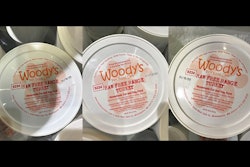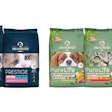
Woof Whiskers pet food market analysts reviewed the nutrient contents of the dog foods on Chewy.com and calculated the average nutrient breakdown. For the 1,300 dog foods included in the calculations, the average nutrient breakdown was 28.9 percent protein, 15.5 percent fat and 50 percent carbs. Crude fiber made up the remaining approximately five percent.
Overall, fat content varied the least among dog foods sold on Chewy.com. Carbohydrates varied the most.
The majority of the dog foods met Association of American Feed Control Officials (AAFCO) guidelines. Some varieties contained less that the recommended levels of protein, but there were reasons for this.
“The AAFCO recommends a minimum of 18 percet protein in adult dogs and 22.5 percent in puppies or lactating dogs,” wrote Woof Whiskers analysts. “In the dog foods we looked at, we only found six dog foods with less than 18 percent protein contents, all of which were prescription blends for dogs with kidney issues. A low-protein diet lets kidneys not work as hard, so this makes sense.”
Fifty dog foods contained less that 22.5 percent protein, but many of these were prescription diets or limited ingredient formulas meant for dogs with health issues.
To calculate nutrient content averages, Woof Whiskers researchers used dry matter protein, fat and carbohydrate levels listed on dog food labels for products sold on Chewy.com. By combining that data with price-per-pound calculations, they were able to conduct further analysis.
Price per pound relationship with protein content
Hypothetically, price-per-pound should vary directly with protein content, since protein sources are one the more expensive ingredients in pet food, wrote Woof Whiskers analysts.
“One thing we’ve always wondered is do more expensive foods tend to have higher protein content?” they wrote.
While price-per-pound and protein content did tend to be correlated, it wasn’t always the case and wasn’t as strong as analysts conjectured.
“One explanation for this lack of relationship between price per pound and protein contents could simply be there’s no real relationship between the two and my expectations are just incorrect!” they wrote. “Many of the most expensive dog foods are still not very high in protein comparatively, so if you’re looking for a high-protein dog food don’t assume the expensive bags are what you’re after.”


















